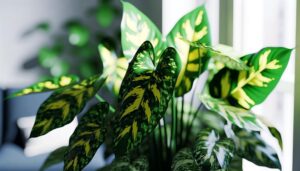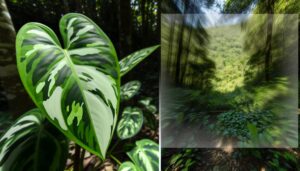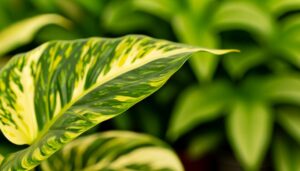What Is a Philodendron Cordatum Petite?
The Philodendron Cordatum Petite is a compact, low-maintenance houseplant from South America's tropical rainforests, belonging to the Araceae family. Known for its heart-shaped, glossy green leaves, it typically grows to a height of 6 to 12 inches.
Ideal growing conditions include bright, indirect light, temperatures between 65-80°F, and humidity levels of 40-60%. It thrives in well-draining soil rich in organic matter.
Notable for its air-purifying qualities, it enhances indoor air quality by filtering toxins. Adaptable and visually appealing, this plant is a popular choice for both residential and commercial décor.
Learn more to optimize care and propagation.
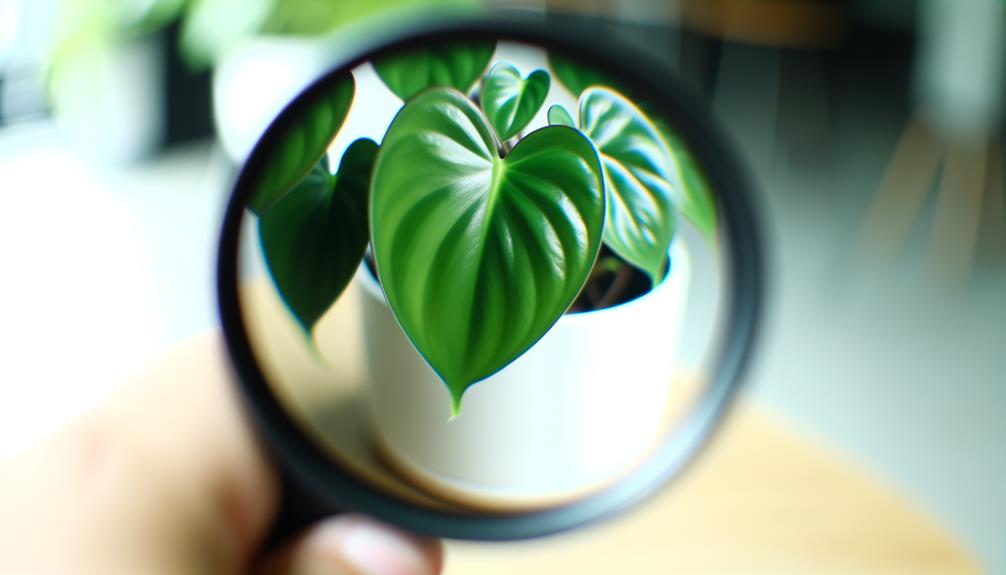
Key Takeaways
- Member of Araceae family, originating from tropical rainforests of South America.
- Compact growth habit, typically 6 to 12 inches in height with heart-shaped, glossy, deep green leaves.
- Thrives in bright, indirect light, with ideal temperatures between 65-80°F and humidity levels of 40-60%.
- Low maintenance needs, requiring minimal watering, occasional misting, and monthly fertilization during the growing season.
- Air purification qualities, filtering toxins like formaldehyde, benzene, and trichloroethylene, enhancing indoor air quality.
Origin and Background

The Philodendron Cordatum Petite, a member of the Araceae family, originates from the tropical rainforests of South America, particularly Brazil. This species thrives in humid, shaded environments, which replicate its native under-canopy habitat.
Adapted to a range of light conditions, it is known for its resilience and versatility. The name 'Cordatum' is derived from the Latin word for 'heart-shaped,' referencing the plant's distinct leaf morphology. This variety of philodendron is a popular choice for indoor cultivation due to its manageable size and low maintenance requirements.
Additionally, it plays a role in air purification, contributing to indoor air quality. Understanding the plant's origins allows for better replication of its natural conditions, ensuring ideal growth and health in domestic settings.
Physical Characteristics
Exhibiting heart-shaped leaves, Philodendron Cordatum Petite features a compact growth habit that makes it ideal for small indoor spaces. This diminutive variety of the Philodendron genus typically measures between 6 to 12 inches in height, maintaining a manageable size.
Its leaves are characterized by a glossy, deep green hue and smooth texture, adding an elegant aesthetic to its surroundings. Each leaf generally spans 2 to 4 inches in length, contributing to the plant's overall delicate appearance.
Stems are slender yet sturdy, supporting the foliage effectively. The plant's vining nature allows it to cascade gently from pots or hanging baskets. Overall, its diminutive stature and attractive foliage make it a suitable choice for enhancing indoor environments.
Ideal Growing Conditions

Philodendron Cordatum Petite flourishes in bright, indirect light, making it well-suited for indoor environments where it can receive filtered sunlight.
Best temperatures for this plant range between 65-80°F (18-27°C), ensuring a stable and moderate climate.
Humidity levels should be maintained around 40-60%, replicating its native tropical habitat. This species demonstrates notable resilience but should be shielded from direct sunlight to prevent leaf scorch.
Air circulation is also essential to avoid fungal diseases; hence, positioning the plant in a well-ventilated area is recommended.
Watering should be consistent yet moderate, allowing the top inch of soil to dry out between watering sessions. Adhering to these conditions will promote healthy growth and vibrant foliage for the Philodendron Cordatum Petite.
Soil and Potting Needs
Optimal soil composition for Philodendron Cordatum Petite consists of a well-draining mix enriched with organic matter to maximize both aeration and moisture retention. Utilizing a substrate that balances these elements is essential for best root health and growth. A blend of peat moss, perlite, and pine bark is recommended. The peat moss provides essential nutrients and retains moisture, while perlite improves drainage, and pine bark enhances aeration.
| Ingredient | Function |
|---|---|
| Peat Moss | Nutrient retention |
| Perlite | Enhances drainage |
| Pine Bark | Boosts aeration |
Selecting the right pot is equally important. Containers should have adequate drainage holes to prevent waterlogging. Regular repotting every 1-2 years supports sustained growth and guarantees the plant has ample space for root development.
Watering Requirements
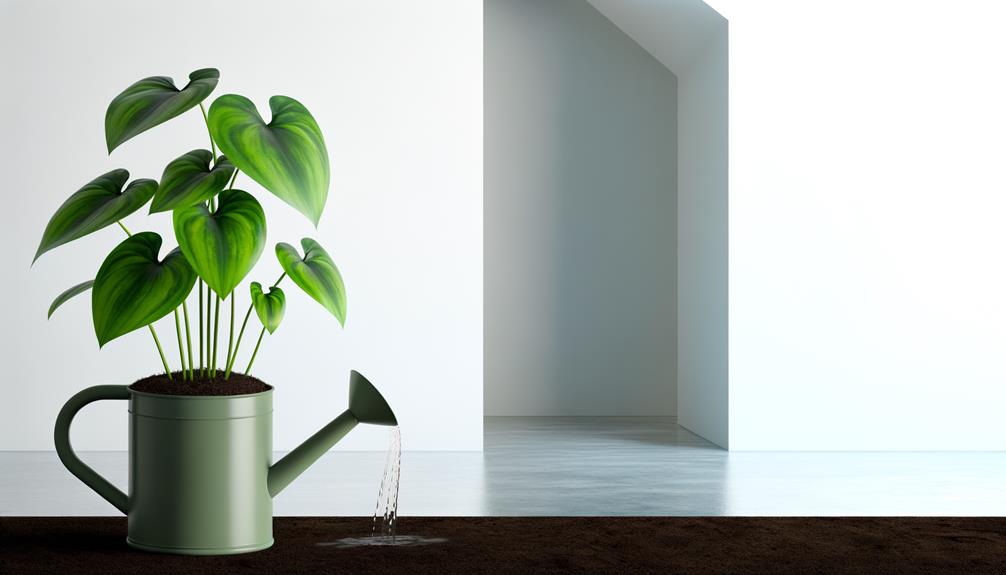
Proper watering is essential for maintaining the health of Philodendron Cordatum Petite. This plant thrives in consistently moist soil, but it is susceptible to overwatering, which can cause root rot.
Additionally, watering frequency should be adjusted seasonally to accommodate variations in temperature and humidity.
Ideal Moisture Levels
Maintaining ideal moisture levels is necessary for the health and growth of Philodendron Cordatum Petite. This species thrives in consistently moist, but not waterlogged, soil. The best practice involves watering thoroughly when the top inch of the soil becomes dry.
Using well-draining potting mix and containers with drainage holes is essential to prevent water accumulation. Humidity also plays a key role; maintaining ambient humidity levels between 40-60% is advantageous. Employing a hygrometer can help monitor these levels accurately.
Additionally, misting the leaves periodically can improve humidity around the plant. Adhering to these moisture guidelines ensures that the Philodendron Cordatum Petite retains its vibrant foliage and robust growth, making it an exemplary specimen in any indoor plant collection.
Overwatering Warning Signs
Detecting excessive watering early is crucial to prevent root rot and other health issues in Philodendron Cordatum Petite. Key indicators of excessive watering include:
- Yellowing Leaves: Leaves may turn yellow and feel limp or mushy, indicating too much water intake and lack of oxygen to roots.
- Foul Odor: A musty or unpleasant smell emanating from the soil suggests root decay, a direct consequence of excessive watering.
- Mold Growth: Presence of mold or fungal growth on the soil surface or plant base signifies consistently wet conditions.
Monitoring these signs closely can help mitigate damage and ensure prime plant health. Proper drainage and allowing the soil to dry between watering sessions can greatly reduce the risk of excessive watering for this species.
Seasonal Watering Changes
Seasonal changes require adjustments in watering schedules for Philodendron Cordatum Petite to accommodate shifts in temperature, humidity, and light exposure.
During the warm growing months of spring and summer, increased water needs are typical due to higher evaporation rates and accelerated plant metabolism. Consistent soil moisture is crucial, but avoid waterlogging.
In contrast, during fall and winter, the plant's growth rate diminishes, reducing its water requirements. Consequently, watering frequency should be decreased to prevent root rot. Monitoring the top inch of soil for dryness before watering is recommended.
Additionally, consider the indoor environment's humidity levels; supplemental humidity may be necessary during dry winter months.
Adapting watering practices seasonally ensures prime hydration and overall plant health.
Light Preferences
Philodendron cordatum petite thrives in bright, indirect light, which mimics its natural habitat beneath the forest canopy. Direct sunlight can scorch its delicate leaves, leading to discoloration and reduced growth. For best results, consider the following light conditions:
- Filtered Light: Position near east or west-facing windows with sheer curtains to diffuse the sunlight.
- Artificial Light: Utilize fluorescent or LED grow lights, particularly in areas with limited natural light, ensuring a minimum of 12-14 hours of light daily.
- Shade Tolerance: While adaptable to low light, prolonged exposure to less-than-ideal lighting may lead to leggier growth and diminished foliage density.
Maintaining these light conditions will support the plant's overall health and aesthetic appeal.
Common Pests and Diseases
Common pests and diseases affecting Philodendron cordatum petite include spider mites, mealybugs, aphids, and fungal infections such as root rot. These pests typically feed on plant sap, weakening the plant and causing leaf yellowing or wilting. Fungal infections, often due to overwatering, can lead to root rot, severely damaging the plant's health.
| Pest or Disease | Symptoms |
|---|---|
| Spider Mites | Fine webbing, stippled leaves |
| Mealybugs | White cottony masses |
| Aphids | Sticky residue, distorted growth |
| Root Rot | Brown, mushy roots |
| Fungal Infections | Leaf spots, mold growth |
Prompt identification and treatment are vital. Regularly inspect plants and maintain ideal care conditions to mitigate these issues.
Propagation Methods
Maintaining the health of your Philodendron cordatum petite also involves understanding effective propagation methods to maintain and expand your collection.
The most efficacious techniques for propagating this plant include:
- Stem Cuttings: Select a healthy stem with at least two nodes. Cut just below a node, place it in water or soil, and make certain it receives indirect light and high humidity.
- Air Layering: Create a small wound on a healthy stem, wrap it with moist sphagnum moss, and cover with plastic wrap until roots develop, then cut the new plant away.
- Division: Carefully remove the plant from its pot, gently separate the root ball into sections, and replant each section in suitable potting mix.
These methods promote robust growth and increase your plant collection efficiently.
Benefits of Indoor Growth

Philodendron Cordatum Petite offers significant benefits when cultivated indoors. Primarily due to its air purification qualities and low maintenance needs.
This plant effectively removes common indoor pollutants, contributing to a healthier living environment. Additionally, its minimal care requirements make it an ideal choice for both novice and experienced plant enthusiasts.
Air Purification Qualities
The Philodendron cordatum petite demonstrates significant air purification qualities, making it a valuable addition to indoor environments. This plant actively removes harmful airborne toxins, thereby enhancing indoor air quality.
Key pollutants mitigated by the Philodendron cordatum petite include:
- Formaldehyde: Commonly found in household products like furniture and cleaning supplies, it is effectively absorbed by the plant.
- Benzene: Emitted from sources such as paints and plastics, benzene is efficiently filtered, reducing potential health risks.
- Trichloroethylene: Often present in various solvents and adhesives, this toxic compound is also eliminated.
These air purification capabilities not only contribute to a healthier living space but also support cognitive function and overall well-being for inhabitants.
Low Maintenance Needs
One of the standout benefits of growing Philodendron cordatum petite indoors is its minimal maintenance requirements, which make it an ideal choice for both novice and experienced plant enthusiasts.
This hardy species thrives under a variety of light conditions, from low to bright indirect light, eliminating the need for constant repositioning. Its watering needs are modest; the soil should be kept lightly moist but allowed to dry out between waterings to prevent root rot.
Additionally, the plant is relatively pest-resistant, reducing the need for frequent chemical treatments. Fertilizing once a month during the growing season is sufficient.
The Philodendron cordatum petite's low maintenance and adaptability to indoor environments make it an excellent addition to any home or office.
Decorative Uses
Incorporating Philodendron Cordatum Petite into interior design schemes can enhance aesthetic appeal while promoting a sense of tranquility. This versatile plant is ideal for various decorative applications due to its compact size and heart-shaped leaves. Importantly, it thrives in different lighting conditions, making it suitable for both residential and commercial settings.
Key decorative uses include:
- Tabletop Displays: Its petite stature makes it perfect for desks, side tables, or shelves, adding a touch of greenery without overwhelming the space.
- Hanging Planters: When placed in hanging baskets, its trailing vines create a cascading effect, enhancing vertical spaces.
- Terrariums: Its low maintenance and humidity tolerance make it an excellent choice for enclosed glass containers, contributing to modern, miniature garden aesthetics.
Conclusion
To sum up, the Philodendron cordatum petite, with its delicate foliage and humble requirements, showcases nature's irony by flourishing with minimal attention while improving indoor spaces.
This botanical contradiction, sturdy yet elegant, provides a simple answer for individuals looking to add a hint of green without the challenge of botanical knowledge.
Its capacity to thrive in different environments ridicules the challenges typically linked with plant maintenance, making it a perfect choice for beginners and experienced indoor gardeners alike.

